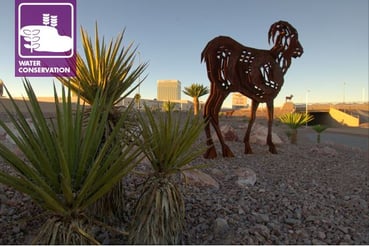
Thanks to our partner EnviroTech for sharing this Axis story with us.
Embracing soil as an important player in water conservation, the ASLA Water Conservation Professional Practice Network spotlights the Nevada Department of Transportation (NDOT) Landscape Architecture, where they have adopted a standard policy of “no irrigation” for southern Nevada freeway landscape enhancements. To respond to that challenge, landscapers are utilizing porous inorganic soil amendments as an aid to increase plant-available water in the soil in a region where rainwater harvesting challenges are unique.
While many of us think of amendments as organic, “porous amendments”, are non-biodegradable minerals that provide physical and structural improvements to soil – above what solid soil granules and organics alone can provide. The most widely used porous amendments are Calcined Diatomaceous Earth, Calcined Clay, and Zeolites, which are all currently approved by the United States Golf Association for golf green rootzone construction. They have the ability to increase watering efficiency by improving infiltration, increasing water holding and plant available water; and exchange air and water continuously with an abundance of internal pores that are the proper size to absorb and release water readily.
Lucy Joyce, head of the Landscape Architecture Section for NDOT sums up the dilemma. “In the Las Vegas area, we receive 5” or less of rainfall per year. Water is a scarce and expensive resource. NDOT has been utilizing sustainable practices and promoting water conservation through the use of native landscaping and techniques that do not require supplemental irrigation. Moving to a “no irrigation” policy reduced the maintenance for our staff while also eliminating the costs for water meters and ongoing water bills. Adding porous amendments helps bridge the gap from planting to establishment for our contractors and us.”
For some initial projects, Cary Baird, Senior Associate and landscape architect with Stantec Consulting Services, Inc. has recently designed and supervised several projects for NDOT and Clark County – all within urban Las Vegas.
“Our design goal was to bring the undisturbed native desert into the urban fabric of a city while reducing long-term maintenance costs. Our plant palette consists of local area native plants and other plant species we introduced from the Mojave Desert that grow in similar climate conditions as Las Vegas. Our design process evaluates the site soil, the plant’s natural air, water and temperature requirements, as well as potential microclimate conditions such as paved area heat gain. Then we generate a custom planting design and backfill blend.”
“All projects that use these unique water harvesting techniques require temporary irrigation from water trucks to help with the establishment of plant materials for the first year. At the end of the establishment period, plants have been weaned to be able to support themselves with the natural rainfall conditions. EP Minerals' Axis calcined diatomaceous earth was applied at 15% by volume with various combinations of topsoil as soil agronomy tests helped determine. Typically, this was blended offsite and then placed as a backfill mix around each plant. Axis has played an important role in improving the localized area around each plant by helping to capture limited rainfall and disperse water to the roots over a longer period. So far, we have been pleased with the plant survival rate with this new approach, and the product has been instrumental in that success."
Read more about AxisDE and Axis Ceramic here: http://blog.epminerals.com/its-axis®-for-golf-courses-landscaping-and-sports-turfs or click the link below:

